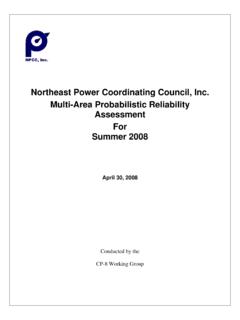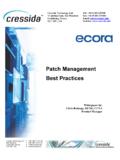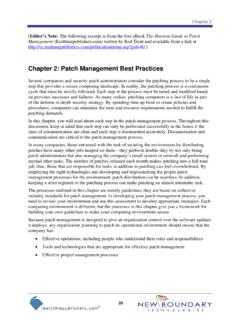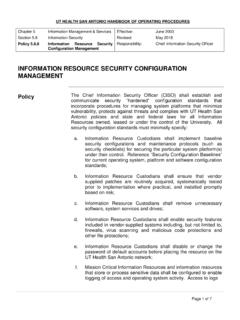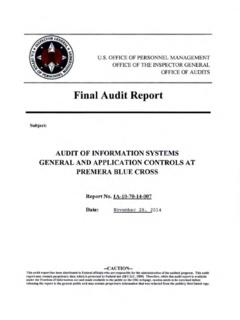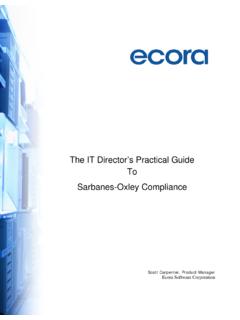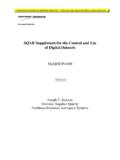Transcription of CIP 007 -5 - npcc.org
1 CIP 007 -5 Transition to Version 5 Val Ayers NPCC Lead CIP Auditor 3/25/2015 1 3/25/2015 2 3/25/2015 3 What Changed? CIP 007 V3a System Security management R1 Test procedures R2 Ports and Services R3 Security patch Mgt. R4 Malicious Software Prevention R5 Account management R6 Security Status Monitoring R7 Disposal or Redeployment R8 Cyber Vulnerability Assessment R9 Documentation Review and Maintenance CIP 007 V5 Systems Security management CIP 010-1 R1 Configuration Change CIP 007-5 R1 Ports and Services CIP 007-5 R2 Security patch Mgt. CIP 007-5 R3 Malicious Code Prevent CIP 007-5 R5 System Access Control CIP 007-5 R4 Security Event Monitor CIP 011-1 R2 Reuse and Disposal CIP 010-1 VA CIP 010-1 R1 Configuration Change 3/25/2015 4 CIP 006-3 and CIP 005-3 Spider Requirements CIP 006-3 Be afforded the protective measures specified in Standard CIP-003-3; Standard CIP-004-3 Requirement R3; Standard CIP-005-3 Requirements R2 and R3; Standard CIP-006-3 Requirements R4 and R5; Standard CIP-007-3; Standard CIP-008-3; and Standard CIP-009-3.
2 CIP 005-3 Cyber Assets used in the access control and/or monitoring of the Electronic Security Perimeter(s) shall be afforded the protective measures as a specified in Standard CIP-003-3; Standard CIP-004-3 Requirement R3; Standard CIP-005-3 Requirements R2 and R3; Standard CIP-006-3 Requirement R3; Standard CIP-007-3 Requirements R1and R3 through R9; Standard CIP-008-3; and Standard CIP-009-3. 3/25/2015 5 CIP 007-5 Ports and Services Part 1 Requirement If a device has no provision for disabling or restricting logical ports on the device then those ports that are open are deemed needed. Protect against the use of unnecessary physical input/output ports used for network connectivity, console commands, or removable media. Evidence An example of evidence may include, but is not limited to, documentation showing types of protection of physical input/output ports, either logically through system configuration or physically using a port lock or signage Guidelines and Technical Basis This control, with its inclusion of means such as signage, is not meant to be a preventative control against intruders.
3 Signage is indeed a directive control, not a preventative one. In essence, signage would be used to remind authorized users to think before you plug anything into one of these systems which is the intent. 3/25/2015 6 CIP 007-5 Ports and Services Guidelines and Technical Basis The protection of these ports can be accomplished in several ways including, but not limited to: Disabling all unneeded physical ports within the Cyber Asset s configuration Prominent signage, tamper tape, or other means of conveying that the ports should not be used without proper authorization Physical port obstruction through removable locks 3/25/2015 7 Lessons Learned Question Signage for physical port protection (CIP-007-5, ) is it acceptable to place signs at the PSP doors, rather than on each individual device port?
4 Response The preferred method of securing the ports is logically disabling the port. If that is not feasible, then the use of port locks should be used. If none of the above are used, then the sign (in the appropriate language for the Responsible Entity) should be as close to the applicable port as possible to be effective to deter inappropriate use of the port. Signage is explicitly allowed as a measure of compliance. If signage is used, it is recommended that entities develop a process addressing the signage s content and strategic placement at the PSP perimeter. 3/25/2015 8 Lessons Learned Question How can tamper tape be used to protect physical ports to comply with this requirement? Response Installing tamper tape over a physical port and recording the serial number or signing the tape can provide visual after-the-fact evidence that a port has been accessed (a detective control).
5 While not preventative in nature, it provides more evidence than either a warning sign (even if attached to a dummy plug placed in the physical port) or physical port blocks that can be removed using a special tool but without a trace that the port block device has been removed. Note that while tamper tape and other similar methods of signage do not prevent unauthorized personnel from accessing these ports, they can be a useful part of a defense-in-depth type of control to remind and deter personnel from unauthorized use of the physical ports. 3/25/2015 9 3/25/2015 10 CIP 007-5 R2 Security patch management Part A patch management process for tracking, evaluating, and installing cyber security patches for applicable Cyber Assets. The tracking portion shall include the identification of a source or sources that the Responsible Entity tracks for the release of cyber security patches for applicable Cyber Assets that are updateable and for which a patching source exists.
6 Evidence An example of evidence may include, but is not limited to, documentation of a patch management process and documentation or lists of sources that are monitored, whether on an individual BES Cyber System or Cyber Asset basis. Guidelines and Technical Basis The SDT s intent of Requirement R2 is to require entities to know, track, and mitigate the known software vulnerabilities associated with their BES Cyber Assets. It is not strictly an install every security patch requirement; the main intention is to be aware of in a timely manner and manage all known vulnerabilities requirement. 3/25/2015 11 CIP 007-5 R2 Security patch management Part At least once every 35 calendar days, evaluate security patches for applicability that have been released since the last evaluation from the source or sources identified in Part Evidence An example of evidence may include, but is not limited to, an evaluation conducted by, referenced by, or on behalf of a Responsible Entity of security-related patches released by the documented sources at least once every 35 calendar days.
7 3/25/2015 12 Guidelines and Technical Basis Determination that a security related patch , hotfix, and/or update poses too great a risk to install on a system or is not applicable due to the system configuration should not require a TFE. 3/25/2015 13 Guidelines and Technical Basis The Responsible Entities can use the information provided in the Department of Homeland Security Quarterly Report on Cyber Vulnerabilities of Potential Risk to Control Systems as a source. The DHS document Recommended Practice for patch management of Control Systems provides guidance on an evaluative process. 3/25/2015 14 CIP 007-5 R2 Security patch management Part For applicable patches identified in Part , within 35 calendar days of the evaluation completion, take one of the following actions: Apply the applicable patches; or Create a dated mitigation plan; or Revise an existing mitigation plan.
8 Mitigation plans shall include the Responsible Entity s planned actions to mitigate the vulnerabilities addressed by each security patch and a timeframe to complete these mitigations. Evidence may include Records of the installation of the patch ( , exports from automated patch management tools that provide installation date, verification of BES Cyber System Component software revision, or registry exports that show software has been installed); or A dated plan showing when and how the vulnerability will be addressed, to include documentation of the actions to be taken by the Responsible Entity to mitigate the vulnerabilities addressed by the security patch and a timeframe for the completion of these mitigations. 3/25/2015 15 Guidelines and Technical Basis Timeframes do not have to be designated as a particular calendar day but can have event designations such as at next scheduled outage of at least two days duration.
9 Mitigation plans in the standard refers to internal documents and are not to be confused with plans that are submitted to Regional Entities in response to violations. 3/25/2015 16 CIP 007-5 R2 Security patch management Part For each mitigation plan created or revised in Part , implement the plan within the timeframe specified in the plan, unless a revision to the plan or an extension to the timeframe specified in Part is approved by the CIP Senior Manager or delegate. Evidence An example of evidence may include, but is not limited to, records of implementation of mitigations. Guidelines and Technical Basis Remediation plans that have steps to be taken to remediate the vulnerability must be implemented by the timeframe the entity documented in their plan.
10 In periods of high demand or threatening weather, changes to systems may be curtailed or denied due to the risk to reliability. 3/25/2015 17 FAQ Question Do assets in use for years ( relays installed 6 years ago) have to be current with security patches and does every security patch in history for the device need to be documented. If not how far back does an entity need to go? Response For any system s initial evaluation for security patch evaluation the evaluation must look back at all applicable security patches for that system. All applicable security vulnerabilities associated with the previously available security patches must be addressed for the scope of the Cyber Asset s system(s) development life cycle or a mitigation plan must be created. 3/25/2015 18 Questions Also, for Medium BES Cyber systems that are that are brought into scope with CIPv5, how for back from the April 2016 implementation deadline would we have to demonstrate the evaluation of historically released patches?



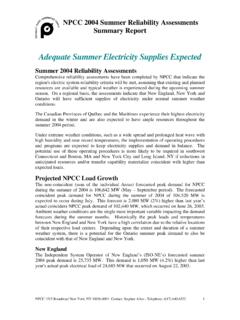


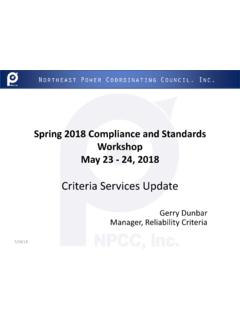

![Welcome [www.npcc.org]](/cache/preview/7/0/4/6/3/8/1/3/thumb-70463813e70cbd881cdccb4a4b4e1de9.jpg)
